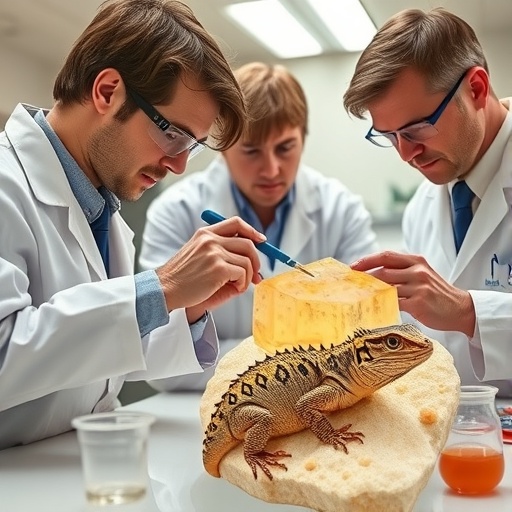Reptiles Have a Unique Way of Excreting Nitrogen: They Pee Crystals
In the animal kingdom, the elimination of nitrogenous waste is vital for maintaining homeostasis. Most creatures excrete waste in the liquid form known as urine. However, reptiles have evolved a remarkable adaptation: instead of liquid urine, they excrete solid urate crystals. This innovative biological strategy was recently studied and elucidated by a team of scientists publishing in the Journal of the American Chemical Society. Through detailed microscopic and X-ray analyses, they revealed that reptiles package nitrogenous waste into microscopic spheres composed mainly of uric acid monohydrate nanocrystals, offering profound insights into biological nitrogen and salt management.
When vertebrates ingest food, nitrogen-containing compounds accumulate as metabolic byproducts, primarily in the form of ammonia, urea, and uric acid. For most mammals, including humans, these nitrogenous wastes are dissolved in water and eliminated as urine. In contrast, many reptiles and birds convert some of these toxic compounds into insoluble urates—solid, crystalline substances—before excretion. This method conserves water, an evolutionary advantage suited for arid environments where water scarcity imposes severe survival challenges.
Researchers led by Jennifer Swift analyzed the solid excreta of more than 20 reptile species, including ball pythons, Angolan pythons, and Madagascan tree boas. High-resolution electron microscopy uncovered that these reptiles excrete urates organized into nanostructured, textured microspheres ranging from 1 to 10 micrometers in diameter. X-ray diffraction further revealed that these spheres consist predominantly of nanocrystals of uric acid monohydrate intermixed with water, forming an intricate crystalline matrix optimized for nitrogen binding and waste stabilization.
The study postulates that uric acid in reptiles serves not merely as waste but also plays a central biochemical role in detoxifying ammonia. Ammonia, generated during protein catabolism, is highly toxic. By converting ammonia into uric acid and subsequently crystallizing it into solid spheres, reptiles significantly reduce the toxicity and enhance the ease of excretion without compromising hydration levels. This dual function highlights a sophisticated natural mechanism evolved over millions of years to balance toxicity mitigation with water conservation.
Interestingly, while the formation of uric acid crystals benefits reptiles, in humans, excess uric acid induces severe health problems such as gout—a painful arthritis caused by urate crystal accumulation in joints—and kidney stones that obstruct the urinary tract. The findings regarding reptilian urates provide a novel framework for understanding the physicochemical principles underlying uric acid crystallization and stability. Such insights could inspire new therapeutic avenues to prevent or treat crystal-related pathologies by mimicking or harnessing nature’s own molecular strategies.
The microspheres created by reptiles are also uniquely textured, differing fundamentally from the sharp, jagged crystals observed in human gout patients. This suggests that reptiles possess specialized biochemical processes or molecular chaperones that control crystal nucleation, growth, and morphology. Understanding these molecular controls could pave the way for biomimetic materials or novel pharmaceutical formulations that safely manage uric acid crystallization in human tissues.
Beyond their biomedical implications, these findings broaden our understanding of evolutionary physiology and nitrogen metabolism across taxa. They illustrate how diverse life forms engineer molecular solutions tailored to their ecological niches, with reptiles exemplifying a remarkable biological innovation that integrates chemistry, crystal engineering, and physiology. Such research exemplifies the synergy between materials science and life sciences, emphasizing the interdisciplinary nature of modern biology.
The researchers emphasized that uric acid’s dual role as a nitrogen carrier and detoxifying agent may extend to humans in subtle ways that remain unexplored. More studies are required to investigate whether human tissues employ analogous crystal formation or solubilization mechanisms to modulate uric acid toxicity under physiological or pathological circumstances. These avenues promise to deepen our comprehension of renal function, metabolic diseases, and the chemical biology of waste products.
This work was supported by grants from the National Science Foundation, Georgetown University, the International Centre for Diffraction Data, and the Chiricahua Desert Museum. It underscores the importance of fundamental chemistry research in revealing nature’s strategies and inspiring novel technological and medical advances. The detailed publication is slated for release on October 22, 2025, in the Journal of the American Chemical Society.
In summary, the discovery that reptiles use nanocrystalline uric acid spheres to excrete nitrogenous waste without water loss not only refines our understanding of vertebrate physiology but also points to potential revolutionary biomedical applications. By learning how reptiles “pee crystals,” scientists hope to develop better treatments for gout, kidney stones, and potentially other diseases related to uric acid metabolism, showcasing the profound benefits of investigating nature’s peculiar and elegant solutions.
Subject of Research: Nitrogen and salt management in reptiles through uric acid monohydrate nanocrystals in excretory systems.
Article Title: Uric Acid Monohydrate Nanocrystals: An Adaptable Platform for Nitrogen and Salt Management in Reptiles
News Publication Date: 22-Oct-2025
Web References: http://dx.doi.org/10.1021/jacs.5c10139
References: Journal of the American Chemical Society, DOI: 10.1021/jacs.5c10139
Image Credits: Adapted from the Journal of the American Chemical Society 2025, DOI: 10.1021/jacs.5c10139
Keywords
Chemistry | Animals | Reptiles
Tags: adaptations of reptilesbiological nitrogen managementcomparative excretion in vertebratesecological advantages of urate excretioninsights into reptile physiologyJournal of the American Chemical Society researchreptile nitrogen excretionreptile species analyzed in studyreptile waste elimination methodssolid urate crystals in reptilesuric acid monohydrate nanocrystalswater conservation strategies





